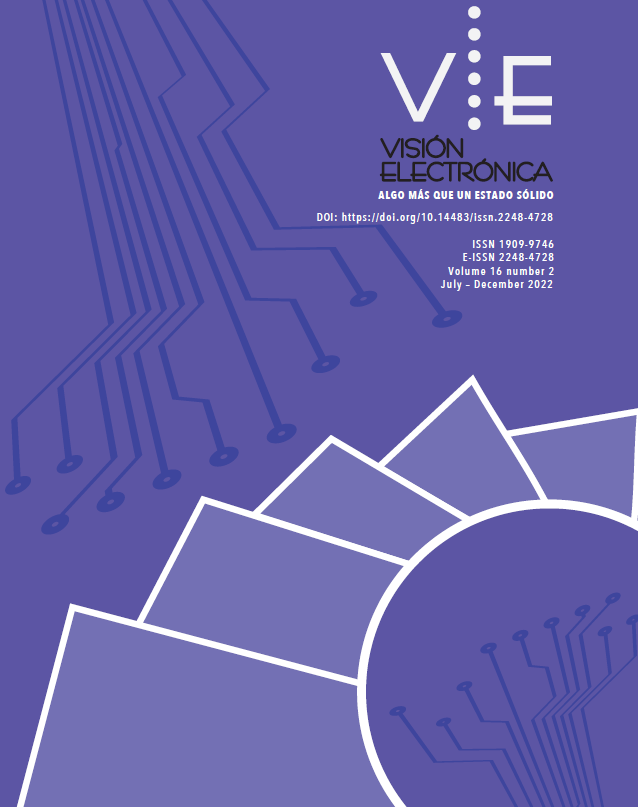Publicado:
2022-08-22Número:
Vol. 16 Núm. 2 (2022)Sección:
Visión InvestigadoraSimulation of transradial prosthesis using Virtual Reality Environment and electrooculography (EOG) signals for grip therapy
Simulación de prótesis transradial haciendo uso de Entorno de Realidad Virtual y señales de electrooculografía (EOG) para terapia de agarre
Palabras clave:
Anthropometry of the hand, Electrooculography (EOG), Grip therapy, Human prehensile models, Transradial prosthesis, Virtual reality environment (en).Palabras clave:
Antropometría de la mano, Electrooculografía (EOG), Terapia de agarre, Modelos prensiles humanos, Prótesis transradial, Entorno de realidad virtual (es).Descargas
Resumen (en)
This article shows the development of an application based on a virtual environment for the area of rehabilitation engineering, providing a new form of validation on prosthetic models, allowing its use in people with transradial amputation and requiring grip therapy in their treatment from 3 types of geometric shapes (cylinder, rectangular prism, sphere), as defined in grasping power objects, using electrooculography signals (EOG).
Resumen (es)
En el presente artículo se muestra el desarrollo de una aplicación basado en un entorno virtual para el área de ingeniería de rehabilitación, proporcionando una nueva forma de validación sobre modelos protésicos, permitiendo su uso en personas con amputación transradial y que requieren terapia de agarre en su tratamiento a partir de 3 tipos de formas geométricas (cilindro, prisma rectangular, esfera), de acuerdo a lo definido en prensión de objetos de poder, haciendo uso de señales de electrooculografía (EOG).
Referencias
L. Agudelo, “La discapacidad en Colombia: una mirada global”, Revista Colombiana de Medicina Física y Rehabilitación, p. 16, 2012.
DANE, “Boletín Censo General 2005 DISCAPACIDAD-COLOMBIA”, 2005. [Online]. Available: https://www.dane.gov.co/files/censos/libroCenso2005nacional.pdf
Ministerio de Salud y Protección Social, “Sala situacional de las Personas con Discapacidad”, 2019. https://www.minsalud.gov.co/sites/rid/Lists/BibliotecaDigital/RIDE/VS/MET/sala-situacional- discapacidad2019-2-vf.pdf
Ministerio de Salud y Protección Social, “Resolución 2968 de 2015”, República de Colombia: Ministerio de Salud y Protección Social, pp. 1–16, 2015.
Ministerio de Salud y Protección Social, “Decreto Número 4725 de 2005”, República de Colombia: Ministerio de Protección Social, pp. 1–31, 2005.
N. Dechev, W. L. Cleghorn, S. Naumann, “Multiple fingers, passive adaptive grasp prosthetic hand”, Mech. Mach. Theory, vol. 36, no. 10, pp. 1157–1173, 2001. https://doi.org/10.1016/S0094-114X(01)00035-0
R. I. Flores Luna, “Repositorio de Tesis DGBSDI: Diseño de protesis mecatronica de mano”, Universidad Nacional Autónoma de México, 2007.
S. R. Kashef, S. Amini, A. Akbarzadeh, “Robotic hand: A review on linkage-driven finger mechanisms of prosthetic hands and evaluation of the performance criteria”, Mechanism and Machine Theory, vol. 145, p. 103677, 2020. https://doi.org/10.1016/j.mechmachtheory.2019.103677
L. Roselia, P. León, E. Luz González Muñoz, Rosalío Ávila Chaurand, “Dimensiones antropométricas de población latinoamericana”, 2007.
M. Monar, L. Murillo, “Diseño y construcción de una prótesis biónica de mano de 7 grados de libertad utilizando materiales inteligentes y control mioeléctrico adaptada para varios patrones de sujeción”, Universidad de las Fuerzas Armadas, Latacunga, 2015.
J. Zhang, B. Wang, C. Zhang, Y. Xiao, M. Y. Wang, “An EEG/EMG/EOG-Based Multimodal Human-Machine Interface to Real-Time Control of a Soft Robot Hand”, Front. Neurorobot., vol. 13, no. 7, p. 7, 2019. https://doi.org/10.3389/fnbot.2019.00007
K. P. Biswajeet Champaty, S. Nayak, “Development of an Electrooculogram-based Human- Computer Interface for Hands-Free Control of Assistive Devices”, Int. J. Innov. Technol. Explor. Eng., vol. 8, no. 4, p. 11, 2019.
R. M. Molano-Pulido, F. Parca-Acevedo, F. M. Cabrera, y H. Ñungo-Londoño, “Prototipo control de vehículo robot por señales EMG”, Vis. Electron., vol. 15, n.º 2, pp. 264–271, 2021. https://doi.org/10.14483/22484728.18948
Q. Huang et al., “An EOG-based wheelchair robotic arm system for assisting patients with severe spinal cord injuries”, J. Neural Eng, vol. 16, 2019. https://doi.org/10.1088/1741-2552/aafc88
D. Saravanakumar, R. Reddy, “A high performance asynchronous EOG speller system”, Biomed. Signal Process. Control, vol. 59, 2020. https://doi.org/10.1016/j.bspc.2020.101898
A. López, M. Fernández, H. Rodríguez, F. Ferrero, O. Postolache, “Development of an EOG- based system to control a serious game”, Meas. J. Int. Meas. Confed., vol. 127, pp. 481–488, 2018. https://doi.org/10.1016/j.measurement.2018.06.017
O. F. Avilés, R. D. Hernández, J. L. Loaiza, J. M. Rosário, “Simulation model of an anthropomorphic hand”, Int. J. Appl. Eng. Res., vol. 11, no. 23, pp. 11114–11120, 2016.
O. F. A. Sánchez, R. Gutiérrez, A. J. U. Quevedo, J. M. Rosario, “(PDF) Antrohopomorphic Grippers-Modelling, Analysis and Implementation”, 2015.
A. Sharma, W. Niu, C. L. Hunt, G. Lévay, R. R. Kaliki, N. Thakor, “Augmented Reality Prosthesis Training Setup for Motor Skill Enhancement”, 2019.
Y. Tsepkovskiy, L. Antonov, C. Kocev, F. Palis, N. Shoylev, “Development of a 3D and VRML virtual hand models for different mechanical gripper”, 2008.
A. Regueiro Gómez, C. B. Busoch Morlán, C. Regueiro Busoch, R. J. Díaz Martínez, “Biomedical Engineering: experiences in the research formation with MOODLE”, Vis. Electron., vol. 14, no. 2, pp. 152–158, 2020. https://doi.org/10.14483/22484728.17424
F. J. Badesa et al., “Physiological responses during hybrid BNCI control of an upper-limb exoskeleton”, Sensors (Switzerland), vol. 19, no. 22, 2019. https://doi.org/10.3390/s19224931
M. R. Cutkosky, “On Grasp Choice, Grasp Models, and the Design of Hands for Manufacturing Tasks”, IEEE Trans. Robot. Autom., vol. 5, no. 3, pp. 269–279, 1989. https://doi.org/10.1109/70.34763
Pontificia Universidad Católica del Perú, “Anexo A Norma DIN 33 402”. [online]. Available: https://tesis.pucp.edu.pe/repositorio/bitstream/handle/20.500.12404/5575/SALAS_CARLOS_PROTESIS_MIOELECTRICA_DESARTICULACION_MU%C3%91ECA_ANEXOS.pdf?sequence=2&isAllowed=y
J. F. Guerrero Martínez, “Ingeniería Biomédica Tema 2 Bioseñales 2.1. Introducción”, 2010.
Cómo citar
APA
ACM
ACS
ABNT
Chicago
Harvard
IEEE
MLA
Turabian
Vancouver
Descargar cita
Visitas
Descargas
Licencia
Derechos de autor 2022 Visión electrónica

Esta obra está bajo una licencia internacional Creative Commons Atribución-NoComercial 4.0.
.png)
atribución- no comercial 4.0 International






.jpg)





